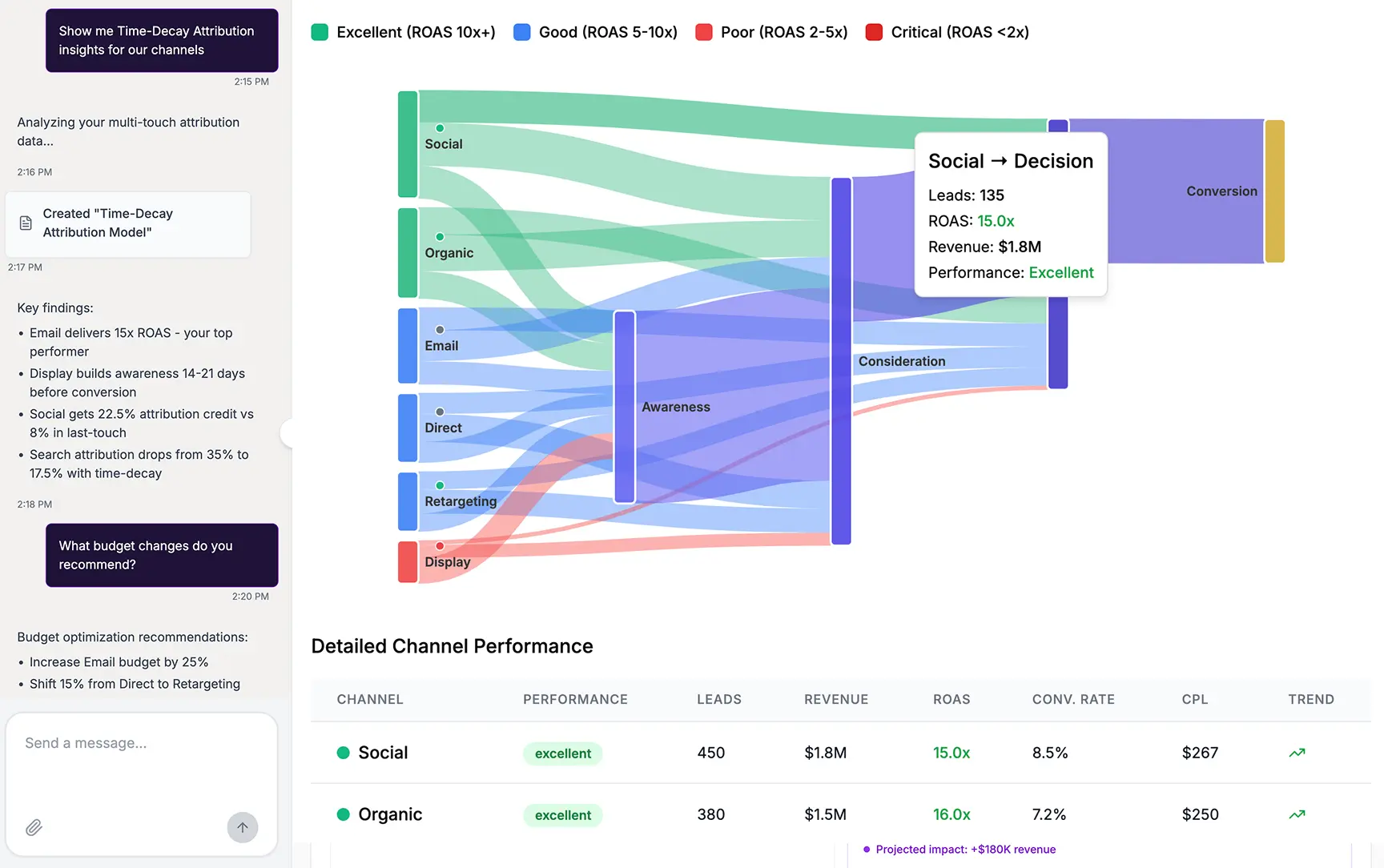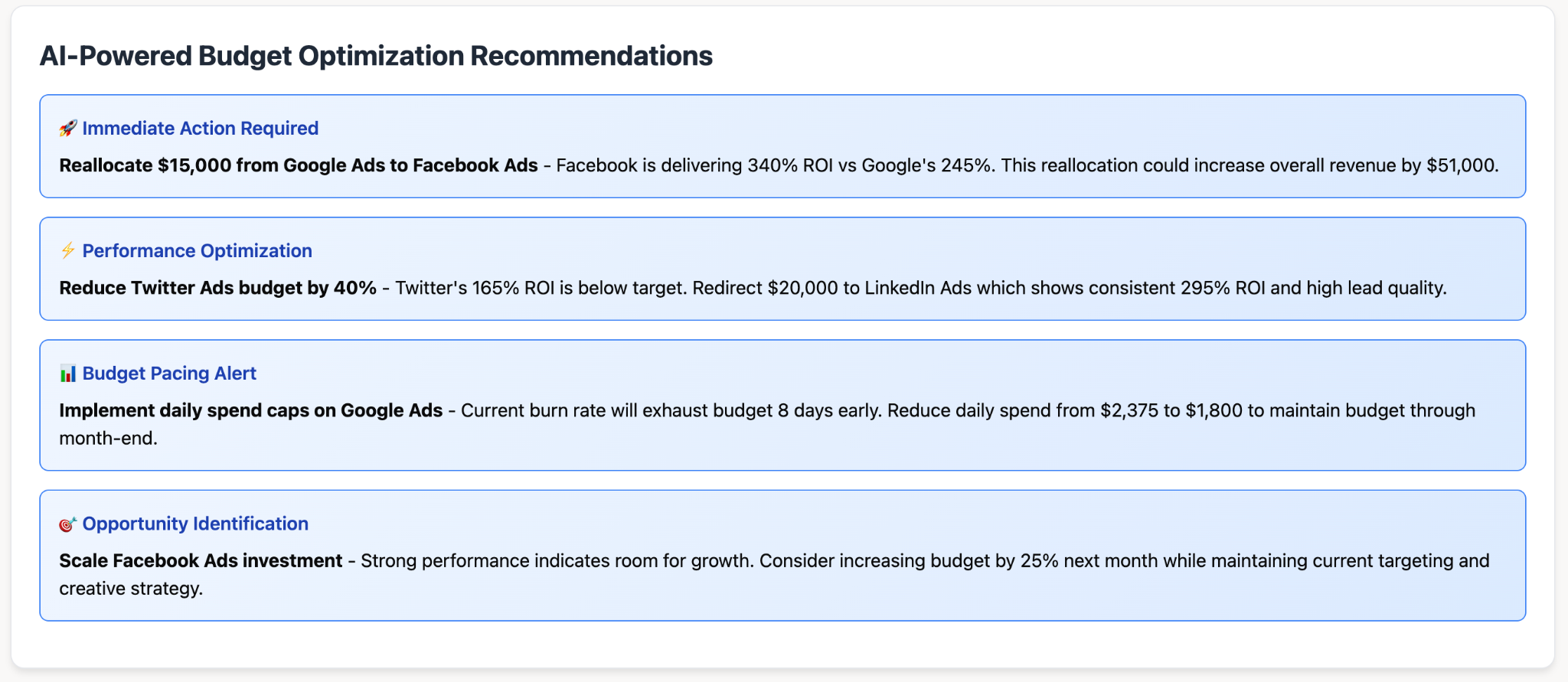Effective marketing today relies not only on creative ideas but also on a clear understanding of performance data. Campaign analytics provides the metrics and insights marketers need to evaluate results, refine strategies, and drive stronger ROI. By analyzing how campaigns perform, businesses can identify what engages their audience, uncover areas for improvement, and make smarter decisions about where to invest their budget.
This article explores the essentials of campaign analytics, covering key metrics, tools, and strategies to help you measure impact and optimize future campaigns.
Key Takeaways
- Campaign analytics links marketing activity directly to revenue, pipeline growth, and customer lifetime value.
- Clean, unified data is critical for accurate reporting and cross-channel performance analysis.
- Real-time monitoring helps catch spend pacing issues and performance anomalies before they impact results.
- 2025 is defined by AI-infused marketing, privacy-aware personalization, real-time monitoring, and first-party data.
- Leverage modern tools (like Improvado, RedTrack, HockeyStack) and AI automation for speed, relevance, and ROI.
What Is Campaign Analytics?
At its core, campaign analytics helps organizations understand not just whether a campaign worked, but why it worked—or didn’t.
It provides clarity on audience behavior and channel effectiveness by answering critical questions: Are we reaching and engaging the right audience segments? Which tactics are driving conversions and revenue? How is each campaign influencing the customer journey and long-term growth?
A campaign analyst’s role goes far beyond reporting. Core responsibilities typically include:
- Data integration and quality assurance: Combining data from multiple platforms and validating accuracy to ensure reliable insights.
- Performance tracking and reporting: Building dashboards and reports that surface key metrics in real time.
- Experimentation and analysis: Running A/B tests, audience segmentation, and trend analysis to optimize campaigns and creative assets.
- Strategic recommendations: Translating complex data into actionable guidance for marketing, sales, and leadership teams.
When done well, campaign analytics acts as the bridge between raw marketing data and business decisions, enabling teams to optimize spend, improve customer experiences, and drive measurable impact.
Why Is Campaign Analytics Crucial for Your Business?
In the current competitive landscape, marketing teams can no longer rely on intuition or siloed reporting to guide decisions.
Campaign analytics provides the data-driven foundation needed to optimize spend, refine targeting, and demonstrate impact across the organization. When implemented effectively, it turns marketing data into a strategic asset that drives growth and accountability.
- Enable Smarter Decisions at Scale: Replace assumptions with clear, data-backed insights. Identify which channels, audiences, and creatives deliver the greatest impact. Use historical performance and near real-time metrics to plan future campaigns and adjust strategies quickly when market conditions change.
- Stretch Budgets and Maximize ROI: Visibility brings efficiency. By comparing performance across campaigns and channels, you can shift resources to the highest-performing tactics. Solutions like Improvado automate attribution and ROI tracking, empowering teams to focus on optimizing ROAS and directly connecting campaigns to revenue outcomes.
- Precision in Targeting: Deep insights into demographics, engagement, and behavioral data allow you to design messaging and offers that resonate with each audience segment, replacing guesswork with evidence-based strategy.
- Agile Optimization Through Testing: Real-time monitoring combined with A/B testing turns campaign management into a continuous improvement loop. Each iteration becomes more precise, resulting in smarter, higher-performing campaigns.
- Build Organizational Alignment and Trust: By connecting metrics like Customer Lifetime Value (CLV) and acquisition cost to campaign spend, marketing teams can clearly demonstrate impact. This transparency fosters alignment between marketing, finance, and leadership, positioning marketing as a key driver of business growth.
Key Campaign Analytics Metrics to Track
Tracking the right metrics is essential for understanding how campaigns perform at every stage of the funnel.
These key metrics provide visibility into audience reach, engagement, conversion efficiency, and overall revenue impact, helping marketers make informed decisions and optimize future strategies.
| Stage | Metric | Why It Matters |
|---|---|---|
| Awareness | Impressions | Shows how many times your ads or content were viewed, indicating overall campaign reach. |
| Awareness | Reach | Measures the number of unique users exposed to your campaign, helping to avoid over-frequency and audience fatigue. |
| Engagement | Click-Through Rate (CTR) | Reveals how compelling your creative and messaging are by showing the percentage of users who clicked after seeing an ad. |
| Engagement | Engagement Rate | Tracks actions such as likes, shares, or comments to gauge how well your content resonates with the audience. |
| Conversion | Conversion Rate | Indicates the effectiveness of your landing pages and calls-to-action in driving desired outcomes. |
| Conversion | Cost per Conversion (CPC or CPA) | Helps determine campaign efficiency by showing the cost of acquiring each conversion or customer. |
| Revenue Impact | Return on Ad Spend (ROAS) | Links ad spend directly to revenue, making it clear which campaigns generate the highest financial return. |
| Revenue Impact | Customer Lifetime Value (CLV) | Assesses the long-term value of acquired customers, guiding investment in retention and acquisition strategies. |
A Step-by-Step Guide to Campaign Analysis
Effective campaign analysis requires a structured, repeatable process that connects data collection, insight generation, and action. By following the six steps below, marketing teams can transform fragmented data into precise, actionable decisions.
At the enterprise level, leveraging a platform like Improvado can automate much of this workflow, unifying data sources, enforcing governance, and enabling advanced analytics without manual effort.
Step 1: Define Objectives and KPIs
Begin with clarity around business intent, whether it’s building brand awareness, driving conversions, or improving customer retention.
From there, identify the key metrics that align with these objectives:
- Awareness: Impressions, reach, engagement rate
- Performance: CTR, conversion rate, cost per acquisition (CPA)
- Revenue Impact: ROAS, Customer Lifetime Value (CLV), pipeline influence
Clear definitions ensure everyone—marketing, finance, leadership—evaluates campaign success on the same terms.
Step 2: Integrate Your Data Sources
Campaign data often lives in silos across ad platforms, CRM systems, email tools, and web analytics. Manual data pulls can work for small teams, but they quickly become inefficient and error-prone as scale increases.
Improvado solves this challenge by connecting to over 500+ marketing and sales platforms, automatically extracting, normalizing, and mapping data into a unified schema.
This centralization streamlines workflows and ensures that every metric flows into a single source of truth—critical for accurate reporting and attribution.
Step 3: Segment Audience and Data
Granular segmentation enables deeper insights and more targeted optimization. Break down data by:
- Audience behavior (e.g., repeat vs. first-time buyers)
- Channel or campaign type
- Creative variations
- Geography or market
By layering these dimensions, teams can uncover hidden trends, test hypotheses, and tailor messaging to specific customer segments. With Improvado, segmentation can be automated through custom data models that are applied consistently across all reporting and BI tools.
Step 4: Monitor Performance in Real Time
Campaign performance can shift quickly, especially in paid channels. Establish live dashboards, automated alerts, and regular review cadences to stay agile.
Real-time monitoring allows teams to:
- Detect spend pacing issues before they spiral out of control
- Pause underperforming campaigns to prevent budget waste
- Redirect investment toward top-performing ads and audiences
- Identify data consistency problems, such as missing UTMs or incorrect naming conventions, before they affect reporting
Step 5: Analyze and Visualize the Results
Once data is centralized and clean, it’s time to dig deeper into performance trends and uncover meaningful insights. Compare current results to KPIs, historical performance, and industry benchmarks to understand where campaigns are excelling and where adjustments are needed.

Traditionally, this analysis required complex queries and BI expertise. With Improvado’s AI Agent, both technical analysts and non-technical business users can explore data instantly by asking questions in plain language. The Agent interprets the request, analyzes the underlying data, and delivers clear, accurate answers in seconds.
Beyond just answering questions, the AI Agent can visualize data, build custom reports, and even generate full dashboards on demand.
This dramatically speeds up the process of turning raw metrics into actionable insights, ensuring decision-makers always have the clarity they need to optimize campaigns and drive growth.
Step 6: Share Insights and Optimize

Insights only drive value when they lead to action. Distribute reports tailored to stakeholders, from executives needing high-level summaries to channel managers requiring tactical details.
Provide clear recommendations, such as reallocating budget, refining audience targeting, or adjusting creative strategy. Close the loop by implementing changes and setting up the next iteration of measurement.
Top Campaign Analytics Tools in 2025
The campaign analytics landscape is evolving rapidly, blending traditional tracking with AI-driven intelligence. Here are the leading categories and tools shaping the space:
- Foundational Analytics Platforms: Google Analytics 4 (GA4) for unified, event-based tracking and Adobe Analytics for advanced segmentation and real-time reporting.
- Business Intelligence & Visualization: Tableau for flexible, interactive dashboards and Domo for cloud-native analytics with predictive capabilities.
- Marketing Intelligence & ETL: Improvado integrates 500+ data sources, automates data cleaning and governance, and feeds insights to BI tools or AI-powered dashboards. Its AI Agent lets teams ask questions in plain language and instantly receive visualized insights and recommendations.
- Ad Attribution & AI Marketing Tools: RedTrack and HockeyStack deliver advanced attribution and performance tracking, both now featuring AI agents for media buyers and growth teams.
- AI Integration & Emerging Models: AI-driven attribution is accelerating, from Improvado’s instant insights to LinkedIn’s transformer-based LiDDA models. Academia is also advancing explainable AI frameworks like SOMONITOR, bridging human intuition with algorithmic precision.
2025 Campaign Analytics Trends to Watch
Campaign analytics is entering a new era shaped by AI, privacy regulations, and the growing demand for real-time insights.
These conditions force marketers to move beyond static reports toward intelligent, automated systems that not only track performance but also guide strategic decisions.
Below are the key trends redefining how campaigns are measured and optimized in 2025:
- AI-Powered Decision-Making Becomes Standard: AI is no longer a nice-to-have; it's embedded in every stage of campaign analysis. This shifts analytics from reactive reporting to proactive decision support.
- Privacy-First Measurement and Clean Rooms: As third-party cookies disappear and privacy regulations tighten, clean rooms like Google Ads Data Hub (ADH) are becoming essential. These environments allow for secure, privacy-compliant measurement while still providing granular insights for attribution, reach, and incrementality analysis.
- Real-Time Monitoring and Governance: Marketers need to detect spend pacing issues, performance anomalies, and data errors as they happen. Marketing Data Governance platforms now provide continuous monitoring, automated checks, and instant alerts, ensuring campaigns stay on budget and compliant while protecting reporting accuracy.
- Cross-Channel Attribution Evolves: Siloed, last-click attribution is giving way to more sophisticated, multi-touch models. AI-driven approaches, like LinkedIn's transformer-based LiDDA model, are improving accuracy by dynamically assigning credit across touchpoints and predicting future outcomes.
- Integration of AI with BI and Visualization Tools: Analytics workflows are becoming more seamless, as AI-driven platforms connect directly with BI tools like Tableau and Looker Studio. This enables instant insight generation and visualization without manual data prep, drastically reducing the time between data collection and decision-making.
- Focus on Incrementality and True ROI: With rising ad costs, marketers are under pressure to prove the incremental value of their campaigns. Incrementality testing, lift studies, and advanced cohort analysis are moving to the forefront, helping teams distinguish between organic conversions and true campaign-driven results.
Turn Complex Campaign Data Into Actionable Insights
Marketing teams today face fragmented data, inconsistent reporting, and slow manual processes that keep them from making timely, confident decisions.
Improvado solves these challenges by unifying campaign data from 500+ sources, enforcing data governance, and delivering instant insights through AI-powered reporting. With clean, centralized data, teams can focus on optimizing performance instead of fixing spreadsheets.
Book a demo to see how Improvado can transform your campaign analytics workflow.
.png)
.jpeg)


.png)
